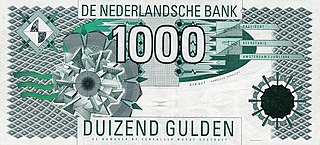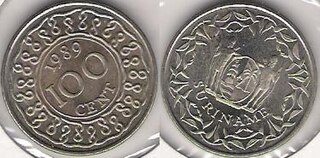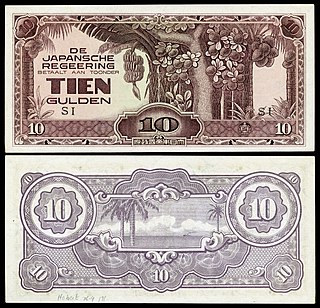A currency is a standardization of money in any form, in use or circulation as a medium of exchange, for example banknotes and coins. A more general definition is that a currency is a system of money in common use within a specific environment over time, especially for people in a nation state. Under this definition, the British Pound sterling (£), euros (€), Japanese yen (¥), and U.S. dollars (US$) are examples of (government-issued) fiat currencies. Currencies may act as stores of value and be traded between nations in foreign exchange markets, which determine the relative values of the different currencies. Currencies in this sense are either chosen by users or decreed by governments, and each type has limited boundaries of acceptance; i.e., legal tender laws may require a particular unit of account for payments to government agencies.
Seigniorage, also spelled seignorage or seigneurage, is the difference between the value of money and the cost to produce and distribute it. The term can be applied in two ways:

A banknote – also called a bill, paper money, or simply a note – is a type of negotiable promissory note, made by a bank or other licensed authority, payable to the bearer on demand. Banknotes were originally issued by commercial banks, which were legally required to redeem the notes for legal tender when presented to the chief cashier of the originating bank. These commercial banknotes only traded at face value in the market served by the issuing bank. Commercial banknotes have primarily been replaced by national banknotes issued by central banks or monetary authorities.
An assignat was a monetary instrument, an order to pay, used during the time of the French Revolution, and the French Revolutionary Wars.

The Swiss franc, or simply the franc, is the currency and legal tender of Switzerland and Liechtenstein. It is also legal tender in the Italian exclave of Campione d'Italia which is surrounded by Swiss territory. The Swiss National Bank (SNB) issues banknotes and the federal mint Swissmint issues coins.

The Mississippi Company was a corporation holding a business monopoly in French colonies in North America and the West Indies. In 1717, the Mississippi Company received a royal grant with exclusive trading rights for 25 years. The rise and fall of the company is connected with the activities of the Scottish financier and economist John Law who was then the Controller General of Finances of France. Though the company itself started to become profitable and remained solvent until the collapse of the bubble, when speculation in French financial circles and land development in the region became frenzied and detached from economic reality, the Mississippi bubble became one of the earliest examples of an economic bubble.

The early Canadian banking system was regulated entirely by the colonial government. Primitive forms of banking emerged early in the colonial period to solve the drain of wealth caused by the application of mercantilist theory. The drain of wealth translated into a complete lack of gold or silver bullion in the colonies, and thus, a complete lack of forms of economic exchange and payment.

The Guyanese dollar has been the unit of account in Guyana since 29 January 1839. Originally it was intended as a transitional unit to facilitate the changeover from the Dutch guilder system of currency to the British pound sterling system. The Spanish dollar was already prevalent throughout the West Indies in general, and from 1839, the Spanish dollar unit operated in British Guiana in conjunction with British sterling coins at a standard conversion rate of one dollar for every four shillings and twopence. In 1951 the British sterling coinage was replaced with a new decimal coinage which was simultaneously introduced through all the British territories in the Eastern Caribbean. When sterling began to depreciate in the early 1970s, a switch to a US dollar peg became increasingly attractive as an anti-inflationary measure and the Eastern Caribbean Currency Authority made the switch in October 1975. The Guyanese dollar is normally abbreviated with the dollar sign $, or alternatively G$ to distinguish it from other dollar-denominated currencies.

The Reichsthaler, or more specifically the Reichsthaler specie, was a standard thaler silver coin introduced by the Holy Roman Empire in 1566 for use in all German states, minted in various versions for the next 300 years, and containing 25–26 grams fine silver.

The guilder or florin was the currency of the Netherlands from 1434 until 2002, when it was replaced by the euro.

The guilder was the currency of Suriname until 2004, when it was replaced by the Surinamese dollar. It was divided into 100 cents. Until the 1940s, the plural in Dutch was cents, with centen appearing on some early paper money, but after the 1940s the Dutch plural became cent.

The Netherlands Indies guilder, later the Netherlands Indies roepiah, was the currency issued by the Japanese occupiers in the Dutch East Indies between 1942 and 1945. It was subdivided into 100 cents and replaced the guilder at par.

The history of Canadian currencies began with Indigenous peoples in Canada prior to European contact, when they used items such as wampum and furs for trading purposes. The Indigenous peoples continued to use those items as currency when trade with Europeans began. During the period of French colonization, coins were introduced, as well as one of the first examples of paper currency by a western government. During the period of British colonization, additional coinage was introduced, as well as banknotes. The Canadian colonies gradually moved away from the British pound and adopted currencies linked to the United States dollar. With Confederation in 1867, the Canadian dollar was established. By the mid-20th century, the Bank of Canada was the sole issuer of paper currency, and banks ceased to issue banknotes.
The livre was the currency of New France, the French colony in modern-day Canada. It was subdivided into 20 sols, each of 12 deniers. The New France livre was a French colonial currency, distinguished by the use of paper money.

The lira or pound is the currency of Lebanon. It was formerly divided into 100 piastres but, because of high inflation during the Lebanese Civil War (1975–1990), subunits were discontinued.

Mandats territoriaux were paper bank notes issued as currency by the French Directory in 1796 to replace the assignats which had become virtually worthless. They were land-warrants supposedly redeemable in the lands confiscated from royalty, the clergy and the church after the outbreak of the French Revolution in 1789. In February 1796, 800,000,000 francs of mandats were issued as legal tender to replace the 24,000,000,000 francs of assignats then outstanding. In all about 2,500,000,000 francs of mandats were issued. They were heavily counterfeited and their value depreciated rapidly within six months. In February 1797, they lost their legal tender quality and by May were worth virtually nothing.

Money is any item or verifiable record that is generally accepted as payment for goods and services and repayment of debts, such as taxes, in a particular country or socio-economic context. The primary functions which distinguish money are: medium of exchange, a unit of account, a store of value and sometimes, a standard of deferred payment.

Banknotes of Demerara and Essequibo, issued from 1809 through 1839 were dual-denominated in Guilders and Joes, a term used by the British colonists to refer to the Portuguese gold Johannes coin and the notes that eventually replaced them. Despite roughly 30 years of use, the only Joes known to exist are unissued remainders from the 1830s.

Fiat money is a type of currency that is not backed by a precious metal, such as gold or silver, or backed by any other tangible asset or commodity. Fiat currency is typically designated by the issuing government to be legal tender, and is authorized by government regulation. Since the end of the Bretton Woods system in 1971, the major currencies in the world are fiat money.

Card money was in use in New France in the seventeenth and eighteenth centuries. Official money cards were embossed with a fleur-de-lis and the signatures of the intendant, governor, and treasurer. Private cards would also use the fleur-de-lis and the signature of its debtor. Card money was generally issued, at least initially, in emergency situations when minted currency was in low supply, however over time "playing cards" became more popular and the standard tender. An estimated two million livres in card money is thought to have circulated prior to the British take over of New France territory in the 1760s.



















